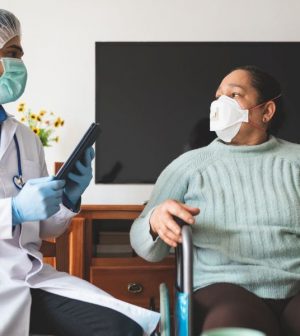- Navigating Your Midlife Crisis: Embracing New Possibilities
- City Raccoons Showing Signs of Domestication
- Mapping the Exposome: Science Broadens Focus to Environmental Disease Triggers
- One Week Less on Social Media Linked to Better Mental Health
- Your Brain Changes in Stages as You Age, Study Finds
- Some Suicide Victims Show No Typical Warning Signs, Study Finds
- ByHeart Formula Faces Lawsuits After Babies Sickened With Botulism
- Switch to Vegan Diet Could Cut Your Greenhouse Gas Emissions in Half
- Regular Bedtime Does Wonders for Blood Pressure
- Dining Alone Could Mean Worse Nutrition for Seniors
Why U.S. Hispanics Got COVID at Higher Rates: Their Jobs

Workplace exposure to the new coronavirus is a major reason for Hispanic Americans’ disproportionately high COVID-19 death rate, a new study claims.
In 2020, Hispanics accounted for 19% of the U.S. population but nearly 41% of COVID-19 deaths, data from the U.S. Centers for Disease Control and Prevention show.
An analysis of federal government data revealed that far higher percentages of working-age (30-69) Hispanics died from COVID-19 than working-age whites. For example, Hispanics aged 35-44 and 55-64 had higher-than-expected proportions of deaths of 15.4 and 8 percentage points, respectively. In contrast, whites in those same age groups had mortality advantages of 23 and 17 percentage points, respectively.
A separate analysis of case estimates found a similar pattern of unequally high COVID-19 infection rates for Hispanics, meaning that the higher death rates among working-age Hispanics is consistent with greater exposure to the virus, according to the authors. The study was published recently in the journal Demographic Research.
“There was no evidence before this paper that really demonstrated that the excess cases were precisely in these working age groups,” said study co-author Reanne Frank, a professor of sociology at Ohio State University.
“Particularly for front-line and essential workers, among whom Hispanics are overrepresented, COVID-19 is an occupational disease that spreads at work,” she said in a university news release. “Hispanics were on the front lines, and they bore a disproportionate cost.”
Knowing that there’s a connection between essential work and a higher rate of COVID-19 deaths should prompt improved workplace protections, said study co-author D. Phuong Do, an associate professor of public health policy and administration at the University of Wisconsin-Milwaukee.
“If we know the source of the spread, then we can tackle it head on,” Do said in the release. “This finding is applicable to any disease that is highly infectious. We can’t stop the economy — we’ve learned that. There has to be a way to protect the workers and enforce protection.”
The researchers said the findings challenge suggestions that disproportionately high COVID-19 death rates among Hispanics and other minorities are driven by preexisting health conditions and/or lower quality health care.
“There’s this impulse when we’re trying to understand racial health disparities — even new ones like COVID that appeared very quickly — to obscure the role of structural factors, which includes work environments,” Frank said.
“This evidence can hopefully set the record straight about why the Hispanic community, along with other groups overrepresented among front-line workers, took such a heavy hit from this pandemic — that it was because they were doing their jobs, and putting themselves on the line,” she said.
More information
The U.S. Centers for Disease Control and Prevention has more on COVID-19 racial/ethnic disparities.
SOURCE: Ohio State University, news release, April 29, 2021
Source: HealthDay
Copyright © 2025 HealthDay. All rights reserved.










